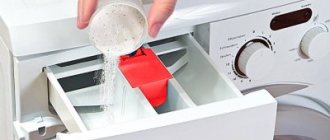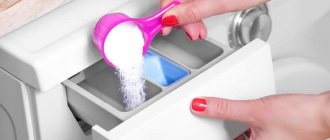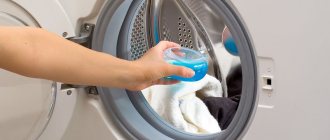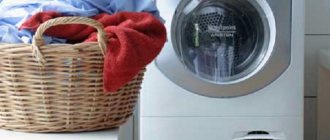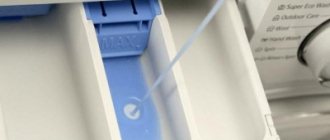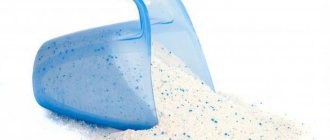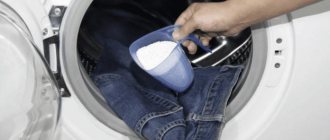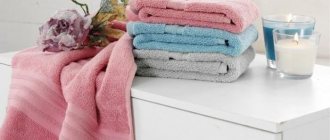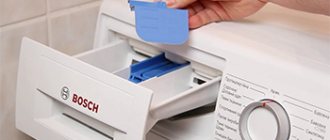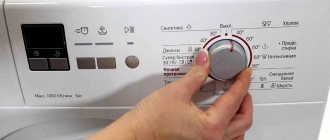Bleaching clothes and bedding by hand is a labor-intensive process that takes a lot of time and effort. But this is nonsense if you have an automatic washing machine.
The question may arise: how to use bleach in the washing machine? How safe is it to use various bleaches when washing in a washing machine?
There are many recommendations that will help you cope with bleaching things that have lost their attractive white color.
Some economy class bleaches are more aggressive, so it is quite possible to return yellowed or grayed items to their former freshness. There are many products that contain bleach.
Next, we will figure out how to use whiteness in the washing machine. You will receive practical advice on how to use chlorine products correctly.
Can you bleach things with bleach?
You need to be careful when using bleach or bleach. This substance is very aggressive, so it is not suitable for all types of fabric. It copes best and safest with yellowness and stains on cotton products; It is worth remembering that frequent bleaching spoils the item.
Interesting materials:
What can you do to stop ads from appearing on your phone? What can be done to prevent the windows on the balcony from freezing? What can be done to solve the acid rain problem? What can you do to stop your dog from barking? What can be done to reduce environmental pollution? What can you do to turn on a laptop without a battery? What can be done to preserve nature? What can be done to protect the environment? What can you do if the bread has dried out? What can you do if your swimsuit has faded?
Using bleach in SMA
Whiteness is a chemical agent. Can I use chlorine bleach in my washing machine? What is the likelihood that the substance will damage the drum or rubber hoses?
Understanding this issue is quite simple: open the instructions for your washing machine. If the use of chlorine products is prohibited, the manufacturer will definitely mention this. If the answer is yes, then the automatic machine model is assembled from plastic pipes, and the drum is made of high-strength metal.
Where to pour bleach
The washing machine has long replaced manual labor. Washing now does not take much time, and having a washing machine at home, you can easily bleach any item, returning it to its original whiteness.
But the question arises: where to put bleach in the washing machine? For this purpose, a special compartment is provided, which is located in the cuvette.
There is a mark on the container that will not allow you to overdo it with the amount of bleach poured.
Do not forget that frequent automatic bleaching may damage parts of the washing machine. It is recommended to use bleach-based substances extremely rarely.
How to achieve results
All SMA owners know where to pour the powder. We suggest you use the instructions for using bleach:
- When starting to bleach things, you should first conduct an inspection. If you find metal products on clothing, it is recommended to remove them. If the parts are not removable, then it is better to use a product that does not contain chlorine. From its influence, metal parts darken.
- Things need to be wetted with cold water and placed in the washing drum.
- If you are doing a small wash, just pour a glass of white into the compartment located in the cuvette. You can add washing powder if necessary.
- If you pour bleach into the drum, you should definitely dilute it with a small amount of water. Such measures will prevent tissue damage.
- Run a program that allows you to set the temperature to no more than 45 degrees. The rinse mode is also suitable.
- Things should be rinsed twice. Why is this necessary? To get rid of the unpleasant smell of bleach. For these purposes, it is ideal to use fabric softener.
- If you plan to bleach thin, lightweight fabrics, you need to know that they should be washed in bleach for no more than 15 minutes. The same applies to colored things. To prevent your clothes or linen from getting damaged, do not forget to monitor the washing process.
These simple rules will help you figure out where to pour the bleach so as not to spoil things.
Why are there three compartments in an automatic washing machine and their designations?
What is the purpose of each compartment in a washing machine?
There are three compartments in a standard automatic washing machine. Each of them is marked with special symbols for ease of use and identification:
- The letter A or the number I mark the compartment for powder used in pre-washing. Some machines do not have this mode, so there is no such compartment either.
- The letter B or number II marks the compartment into which you need to add detergent for the main wash.
- An asterisk or flower designates the compartment for adding rinse aid (conditioner or rinse aid).
How are each of the compartments in the washing machine designated?
If a combination of circumstances occurs when the designations for some reason become invisible, the purpose of the compartment can be determined by its dimensions.
- The smallest compartment is for conditioner/rinse aid.
- The second largest compartment is used in the prewash mode.
- The largest compartment needs to be filled with detergent for the main wash.
Another life hack for finding a compartment for the main wash is to start the machine without powder. During startup, you need to slightly open the drawer with compartments and wait for water to fill. The water will enter the main wash compartment first.
Industrial whitening products
Optical
This is a certain chemical compound capable of reflecting light, this effect is achieved thanks to special dyes that do not wash off when rinsing. And when they come into contact with something sunny, they reflect a bluish tint.
One of the main disadvantages of this product is an allergic reaction. Therefore, they are categorically not recommended for use on children's clothing.
Oxygen
Oxygen bleaches are available in two forms: liquid and powder, perfect for both cotton and delicate fabrics. They are made on the basis of one of two components - carbonate or carbonate peroxyhydrate.
During the splitting process, it breaks down into soda (which has a bleaching effect) and peroxide (which can release oxygen). With the help of which dirt is more effectively separated from the texture of the fabric.
The most popular representatives of this product:
- Bos OXI,
- Vanish oxy.
- Soap nuts.
- Sarma active.
- Persol.
On the packaging of oxygen bleaches, as a rule, the markings Oxy, O2, Active, Oxygen are indicated.
The main advantages of this tool:
- Works great at low temperatures, 40 degrees is enough.
- Does not harm delicate materials.
- Capable of removing old stains.
- Wash well.
- Rarely cause allergic reactions.
- There are compositions for white and for color.
- Removes almost any pollution.
Their main disadvantage is their rather high cost and high consumption.
Chlorine
A fairly reliable and proven product, the active ingredient is sodium hypochlorite, the main advantages include:
- Ability to remove almost any contaminant.
- Affordable price, these funds are budget ones.
- It has an antibacterial effect, as a result you get clean laundry without germs.
Despite all the advantages, there are also disadvantages, since the product acts quite aggressively on the structure of the material, it can only be used for cotton. It is very important to protect yourself from exposure to its fumes; the room should be well ventilated, and you should wear gloves on your hands. The most popular representatives are bleach, whiteness, and Domestos.
How do you bleach laundry?
When washing, you can use different types of bleaching agents:
- Based on active oxygen.
- Chlorine bleaches are cheaper bleaches. They are more aggressive and can cope with the most advanced situations. Housewives use chlorine-containing products to restore the snow-white color even to gray and faded linen.
The most popular bleach is “Whiteness”. This is a potent composition that can act not only on contaminated fabric surfaces, but also on metal and rubber. But chlorine solution is not harmful to plastic, which is why it is sold in plastic containers.
Precautionary measures
Regardless of the form in which Vanish is used (spray, powder or liquid), it is important to adhere to the following precautions:
Never test the cleaning effect of Vanish on handmade items with unstable dyes or silk items.- Experts recommend avoiding contact of Vanish with metal fittings and leather inserts.
- Before use, Vanish must be checked on a small, inconspicuous area of the product.
- When working with Vanish, the room must be ventilated. Also, do not forget about personal protective equipment (gloves for hands, respirator for face).
Contact of the product on unprotected areas of the skin is fraught with the development of allergic reactions: itching, redness. After finishing work with Vanish, be sure to wash your hands under running water and soap.
- If Vanish stain remover or bleach gets on your mucous membranes, you should immediately rinse your eyes or mouth with clean water.
What types of detergents are there and what are they for?
The range of household chemicals stores is wide and varied, and counters with laundry detergents are full of a huge number of bright boxes and bottles. How to figure this out? The main types of washing compositions can be distinguished:
- powders (intended for main wash);
- compositions in the form of liquids (washing gel, rinse aid, stain remover and fabric softener);
- tablets and capsules (contain concentrated compressed laundry detergent or gel).
Whatever product you use, pay attention to the amount of foam formed. If there is too much of it, this indicates that the dose of the substance has been exceeded and needs to be adjusted. Typically, these recommendations can be found on the packaging of the powder or gel.
It is also important to choose products marked “automatic” for machine washing and pour or pour the selected composition only into the appropriate compartment of the tray.
Where to put powder, bleach, conditioner in the washing machine: compartments
Which compartments of the washing machine contain powder, conditioner, and fabric bleach?
- Washing powder is placed in the largest compartment, marked with the letter B or number II.
- Pre-wash powder must be distributed into the middle compartment marked with the letter A and the number I.
- Air conditioning should only be poured into the smallest compartment, indicated by an asterisk or flower. In addition, you can add such a product not only before starting the wash, but also during the washing process. In this case, the main task is to fill the conditioner before rinsing the laundry.
- Bleach, machine anti-scale protectants, stain remover or powder enhancer must be poured into the main wash compartment.
Important! If you mix up the compartments and add laundry detergent incorrectly, you can waste a lot of time and money in vain, since the result is unlikely to be satisfactory. Also, do not put harsh products such as bleach or stain remover into the rinse aid compartment.
Using stain remover
Most powder manufacturers produce liquid laundry detergents. Whiteness for the washing machine is poured into a special compartment designed for this. But many people don’t know where to put the stain remover.
The product is poured into the same container as the washing powder. The stain remover comes off easily when washing. Using a stain remover is an opportunity to remove stains from any item.
Advantages:
- copes with all types of pollution;
- practically does not form foam;
- the ecological composition does not cause skin irritation;
- inexpensive;
- excellent contact with cold water;
- Suitable for all types of fabric.
Knowing where to pour stain remover, whiteness and powder is the key to successful and high-quality washing. You will not have problems with grayed things or stains on your linen.
A washing machine and special products will help you quickly, without much effort, get rid of dirt, and maintain the original shine and brightness of white things.
Features of using bleach
When working with aggressive chemicals, it is important to follow safety rules - not only sheets and washing machine parts can be damaged, but you too. Safety rules when working with chlorine-containing solutions:
- When bleaching, wear gloves and a mask. Contact of the substance with the skin causes burns, corrosion, and allergies.
- It is not advisable to use a stain remover on colored fabrics - the stain will come out, but along with it the color will lose its saturation.
- Do not use on leather, wool and silk items. Stains from them are generally very difficult to remove; compositions with chlorine will only spoil the material or cause the appearance of yellowness. Use is allowed on cotton, linen and synthetic fabrics.
- If the container with “Belizna” has been opened for a long time - six months or more, it is not worth using it, since the chemical effect of the composition is noticeably reduced.
Is it possible to pour powder into the drum of a washing machine?
Is it possible to pour powder directly into the drum of a washing machine?
Some thrifty housewives wonder whether it would be better to pour the powder directly into the drum. It is impossible to answer this question unequivocally, so we will try to list all the advantages and disadvantages of such washing tactics, and then weigh them.
Advantages
- When adding powder directly into the drum, significant budget savings are noticed - much less powder can be used.
- Rinsing is more efficient because the powder is rinsed directly from the drum. When loading powder from the machine compartment, there is a possibility of it sticking to the internal parts of the machine and the penetration of its particles into the laundry during rinsing.
- You can use this method if the powder compartment is broken.
- Special detergents such as capsules and gels have proven themselves very well. According to the instructions, they must be loaded directly into the drum before washing.
Pros and cons of pouring washing powder directly into the machine drum
Disadvantages
- When loading powder directly into the drum, it is advisable to run a longer wash cycle at high temperatures (over 40 degrees) so that the powder is completely dissolved. The fact is that with indirect loading, the powder additionally dissolves before entering the drum.
- Preliminarily emptying the drum of water before washing can wash out a large amount of powder. To prevent this from happening, it is best to use special containers for powder sold in stores.
- By pouring powder directly into the drum, the possibility of pre-washing is eliminated. This mode becomes unavailable, and you cannot pour powder directly into the drum after pre-washing.
- If the washing detergent compartment in the machine is broken, you can still add powder directly, but you won’t be able to use conditioner or rinse aid, since such detergents are used in washing only at the rinsing stage.
- Direct loading of powder eliminates the possibility of using bleaches and stain removers, since it is very dangerous to pour them directly.
Our dear readers, we hope that now, when you open the washing machine drawer for powder, you will not be stunned, but will quickly figure out what needs to be put in where.
Its types
Liquid type powders are divided into several groups:
- Products for specific types of materials: silk, wool, lace, denim, guipure, chiffon and so on.
- Products for dark, white or colored items. These powders allow you to maintain the original characteristics of the products: whiteness, color saturation and brightness. Products in this category are presented in the Tide product range.
- Universal liquid powders can be used to wash items of any color and made from different fabrics.
- Gentle products for sensitive skin or baby items. They do not contain aggressive components that can irritate the delicate skin of a child or person suffering from dermatological diseases. Such products are available in the Ariel range of liquid powders.
- Hypoallergenic liquid powders are suitable for allergy sufferers, as they do not contain additives that can cause unwanted reactions.
- Stain removers, for example, Vanish. They can be used to remove stubborn or old stains that conventional detergents cannot remove.
According to the form of release, the products are divided into gels, packaged in bottles (the caps of some have a convenient measuring scale) and packaged in capsules. The latter are simply placed in the machine and begin to operate when the drum rotates.
How to bleach with oxygen bleach?
The correct proportion is one part product to 30 parts water. For example, this ratio is equal to half a glass of product per 3-4 liters of water (100 ml of bleach per 3 liters of water). Gray items can be bleached. Don't forget about temperature indicators.
Interesting materials:
How to wash a washing machine with citric acid? How to wash vertical fabric blinds? How can I tell if I'm a bad kisser? How can you tell if water has entered the engine? How to understand with or without VAT? How to get from Barcelona to Andorra? How to get to the Asgard tower? How to get to Igromir? How to get hired under a contract? How to get to serve in Syria?
Where do you put gel capsules or laundry tablets?
Not so long ago, laundry detergent compositions in the form of capsules or tablets appeared on the household chemicals market. The capsule, as a rule, contains the product in the form of a gel, while the tablet is a compressed powder that gradually, layer by layer, dissolves during the washing process.
To ensure that your washing machine serves you for a long time and also cleans your laundry efficiently, follow the rules of its operation and you will free up a lot of time while your assistant deals with stains and dirt on things.
Why do things spoil?
In order for the laundry to remain unharmed after treatment with “Whiteness”, it is not enough to know where to pour the product, you also need to know how to use it correctly. In case of violation of the rules:
- wear and tear of things accelerates;
- materials become thinner and worn out;
- things tear, holes appear on them.
Experts do not recommend using bleaches in SMA at all. But experienced people assure: it’s all about the technology of use and the correct dosage. If you do everything correctly, you can get rid of any stains, whiten fabrics and not damage the machine at all.
